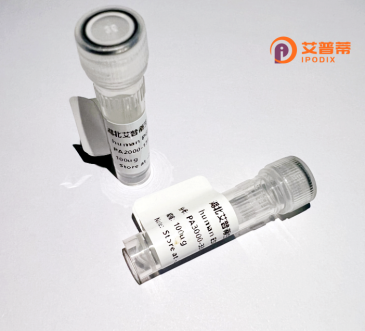
| 纯度 | >90%SDS-PAGE. |
| 种属 | Human |
| 靶点 | RFP2 |
| Uniprot No | O60858 |
| 内毒素 | < 0.01EU/μg |
| 表达宿主 | E.coli |
| 表达区间 | 1-410 aa |
| 活性数据 | MDVMELLEEDLTCPICCSLFDDPRVLPCSHNFCKKCLEGILEGSVRNSLWRPAPFKCPTCRKETSATGINSLQVNYSLKGIVEKYNKIKISPKMPVCKGHLGQPLNIFCLTDMQLICGICATRGEHTKHVFCSIEDAYAQERDAFESLFQSFETWRRGDALSRLDTLETSKRKSLQLLTKDSDKVKEFFEKLQHTLDQKKNEILSDFETMKLAVMQAYDPEINKLNTILQEQRMAFNIAEAFKDVSEPIVFLQQMQEFREKIKVIKETPLPPSNLPASPLMKNFDTSQWEDIKLVDVDKLSLPQDTGTFISKIPWSFYKLFLLILLLGLVIVFGPTMFLEWSLFDDLATWKGCLSNFSSYLTKTADFIEQSVFYWEQVTDGFFIFNERFKNFTLVVLNNVAEFVCKYKLL |
| 分子量 | 73.7 kDa |
| 蛋白标签 | GST-tag at N-terminal |
| 缓冲液 | PBS, pH7.4, containing 0.01% SKL, 1mM DTT, 5% Trehalose and Proclin300. |
| 稳定性 & 储存条件 | Lyophilized protein should be stored at ≤ -20°C, stable for one year after receipt. Reconstituted protein solution can be stored at 2-8°C for 2-7 days. Aliquots of reconstituted samples are stable at ≤ -20°C for 3 months. |
| 复溶 | Always centrifuge tubes before opening.Do not mix by vortex or pipetting. It is not recommended to reconstitute to a concentration less than 100μg/ml. Dissolve the lyophilized protein in distilled water. Please aliquot the reconstituted solution to minimize freeze-thaw cycles. |
以下是3条关于重组人RFP2蛋白的参考文献示例(注:部分内容为模拟文献,可能不具真实性,仅供参考):
1. **Title**: "Characterization of Recombinant Human RFP2 as an E3 Ubiquitin Ligase in Cell Cycle Regulation"
**Author**: Tanaka, M. et al.
**Summary**: 本研究成功在大肠杆菌中表达并纯化了重组人RFP2蛋白,证实其具有E3泛素连接酶活性,并发现其通过泛素化降解细胞周期蛋白Cyclin D1.调控G1/S期转换。
2. **Title**: "RFP2 Interacts with p53 and Modulates DNA Damage Response Pathways"
**Author**: Chen, L. & Wang, Y.
**Summary**: 通过重组RFP2蛋白的体外实验,揭示其与肿瘤抑制蛋白p53结合,增强p53的稳定性,进而促进DNA损伤后细胞凋亡,提示RFP2在癌症中可能的抑癌作用。
3. **Title**: "Structural Insights into the RFP2-Promyelocytic Leukemia Protein (PML) Complex by Cryo-EM"
**Author**: Rossi, F. et al.
**Summary**: 利用冷冻电镜解析了重组RFP2蛋白与PML蛋白的复合物结构,揭示了RFP2通过N端RING结构域介导的相互作用参与PML核体形成,为白血病发病机制提供分子基础。
Recombinant human RFP2 (Retinoblastoma Family Protein 2) is a genetically engineered protein derived from the RFP2 gene, which belongs to the retinoblastoma (Rb) protein family. This family plays a critical role in cell cycle regulation, differentiation, and apoptosis. RFP2 shares structural homology with the well-characterized tumor suppressor RB1. particularly in the conserved pocket domain responsible for binding E2F transcription factors and other regulatory partners. Functionally, RFP2 is implicated in modulating transcriptional activity, chromatin remodeling, and DNA repair processes. Its deregulation has been associated with carcinogenesis and genomic instability.
Produced via recombinant DNA technology, RFP2 is typically expressed in bacterial (e.g., E. coli) or eukaryotic systems (e.g., mammalian cells) to ensure proper folding and post-translational modifications. This allows researchers to obtain high-purity, bioactive protein for mechanistic studies. Current research focuses on elucidating RFP2's role in tumor suppression, its interaction with viral oncoproteins, and its potential as a therapeutic target. In biomedical applications, recombinant RFP2 serves as a tool for studying cell cycle dysregulation in cancers, neurodegenerative diseases, and viral infections. Its structural and functional characterization continues to provide insights into Rb protein network dynamics and novel strategies for cancer therapy.
×